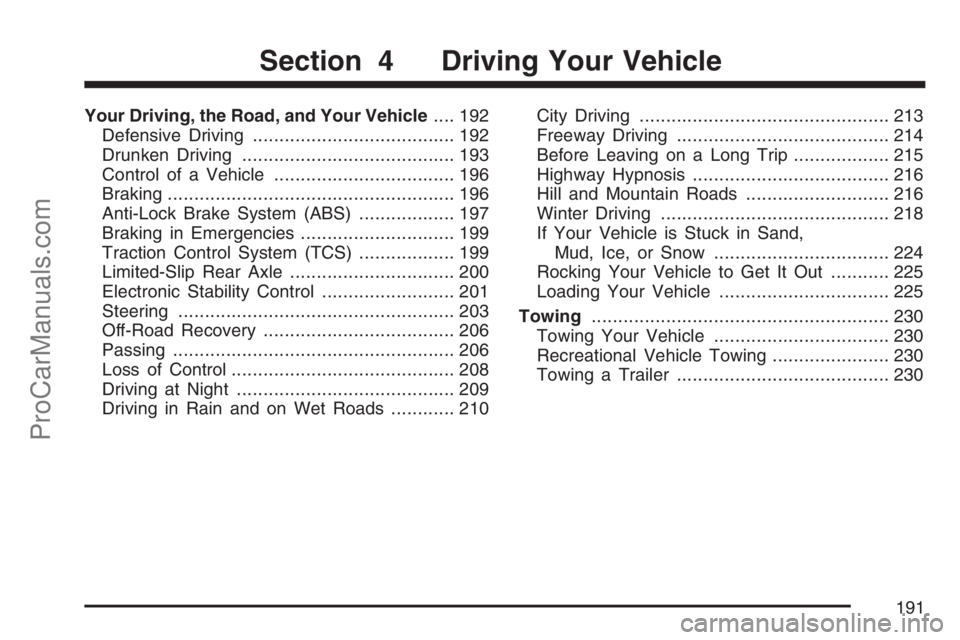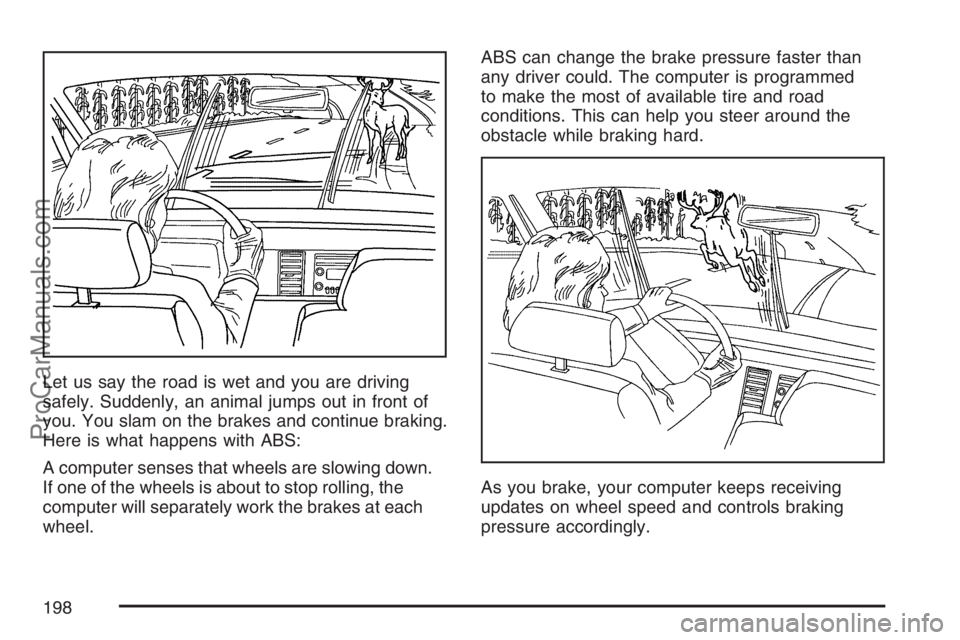2007 SATURN SKY ABS
[x] Cancel search: ABSPage 135 of 384

Anti-Lock Brake System
Warning Light
Your vehicle may have
the Anti-Lock Brake
System (ABS).
This light will come on when your engine is
started and may stay on for several seconds.
That is normal.
If the light stays on, turn the ignition off. If the
light comes on when you are driving, stop as soon
as possible and turn the ignition off. Then start
the engine again to reset the system. If the
light still stays on after driving at a speed of at
least 13 mph (20 km/h), or comes on again
while you are driving, your vehicle needs service.If the regular brake system warning light is not
on, you still have brakes, but you do not have
anti-lock brakes. If the regular brake system
warning light
is also on, you do not have anti-lock brakes and
there is a problem with your regular brakes.
SeeBrake System Warning Light on page 134.
The ABS warning light will come on brie�y
when you turn the ignition key to RUN. This is
normal. If the light does not come on then, have
it �xed so it will be ready to warn you if there
is a problem.
135
ProCarManuals.com
Page 191 of 384

Your Driving, the Road, and Your Vehicle.... 192
Defensive Driving...................................... 192
Drunken Driving........................................ 193
Control of a Vehicle.................................. 196
Braking...................................................... 196
Anti-Lock Brake System (ABS).................. 197
Braking in Emergencies............................. 199
Traction Control System (TCS).................. 199
Limited-Slip Rear Axle............................... 200
Electronic Stability Control......................... 201
Steering.................................................... 203
Off-Road Recovery.................................... 206
Passing..................................................... 206
Loss of Control.......................................... 208
Driving at Night......................................... 209
Driving in Rain and on Wet Roads............ 210City Driving............................................... 213
Freeway Driving........................................ 214
Before Leaving on a Long Trip.................. 215
Highway Hypnosis..................................... 216
Hill and Mountain Roads........................... 216
Winter Driving........................................... 218
If Your Vehicle is Stuck in Sand,
Mud, Ice, or Snow ................................. 224
Rocking Your Vehicle to Get It Out........... 225
Loading Your Vehicle................................ 225
Towing........................................................ 230
Towing Your Vehicle ................................. 230
Recreational Vehicle Towing...................... 230
Towing a Trailer........................................ 230
Section 4 Driving Your Vehicle
191
ProCarManuals.com
Page 197 of 384

Avoid needless heavy braking. Some people drive
in spurts — heavy acceleration followed by
heavy braking — rather than keeping pace with
traffic. This is a mistake. The brakes may not have
time to cool between hard stops. The brakes
will wear out much faster if you do a lot of heavy
braking. If you keep pace with the traffic and
allow realistic following distances, you will
eliminate a lot of unnecessary braking. That means
better braking and longer brake life.
If your vehicle’s engine ever stops while you are
driving, brake normally but do not pump the
brakes. If you do, the pedal may get harder to
push down. If the engine stops, you will still have
some power brake assist. But you will use it
when you brake. Once the power assist is used
up, it may take longer to stop and the brake pedal
will be harder to push.
Adding non-Saturn accessories can affect your
vehicle’s performance. SeeAccessories and
Modi�cations on page 233.Anti-Lock Brake System (ABS)
Your vehicle has the Anti-Lock Brake System
(ABS), an advanced electronic braking system
that will help prevent a braking skid.
When you start your engine and begin to drive
away, ABS will check itself. You may hear a
momentary motor or clicking noise while this test
is going on, and you may even notice that
your brake pedal moves a little. This is normal.
If there is a problem
with ABS, this warning
light will stay on.
SeeAnti-Lock Brake
System Warning
Light on page 135.
197
ProCarManuals.com
Page 198 of 384

Let us say the road is wet and you are driving
safely. Suddenly, an animal jumps out in front of
you. You slam on the brakes and continue braking.
Here is what happens with ABS:
A computer senses that wheels are slowing down.
If one of the wheels is about to stop rolling, the
computer will separately work the brakes at each
wheel.ABS can change the brake pressure faster than
any driver could. The computer is programmed
to make the most of available tire and road
conditions. This can help you steer around the
obstacle while braking hard.
As you brake, your computer keeps receiving
updates on wheel speed and controls braking
pressure accordingly.
198
ProCarManuals.com
Page 199 of 384

Remember: ABS does not change the time you
need to get your foot up to the brake pedal or
always decrease stopping distance. If you get too
close to the vehicle in front of you, you will not have
time to apply your brakes if that vehicle suddenly
slows or stops. Always leave enough room up
ahead to stop, even though you have ABS.
Using ABS
Do not pump the brakes. Just hold the brake pedal
down �rmly and let anti-lock work for you. You may
hear the anti-lock pump or motor operate, and feel
the brake pedal pulsate, but this is normal.
Braking in Emergencies
With ABS, you can steer and brake at the same
time. In many emergencies, steering can help you
more than even the very best braking.
Traction Control System (TCS)
Your vehicle may have a traction control
system called TCS that limits wheel spin. This
is especially useful in slippery road conditions.The system operates only if it senses that the rear
wheels are spinning too much or are beginning
to lose traction. When this happens, the system
works the rear brakes and reduces engine
power (by closing the throttle and managing
engine spark) to limit wheel spin.
This light will �ash
when your traction
control system is
limiting wheel spin.
You may feel or hear
the system working,
but this is normal.
SeeElectronic Stability Control (ESC)/Traction
Control System (TCS) Indicator/Warning Light
(2.0L Engine Only) on page 136for more
information.
If your vehicle is in cruise control when the
traction control system begins to limit wheel spin,
the cruise control will automatically disengage.
When road conditions allow you to safely
use it again, you may re-engage the cruise control.
SeeTurn Signal/Multifunction Lever on page 111.
199
ProCarManuals.com
Page 209 of 384

Remember: Any Anti-Lock Brake System (ABS)
helps avoid only the braking skid.
If the ABS is ever disabled, in a braking skid,
where the wheels are no longer rolling, release
enough pressure on the brakes to get the wheels
rolling again. This restores steering control.
Push the brake pedal down steadily when you
have to stop suddenly. As long as the wheels are
rolling, you will have steering control.
Driving at Night
Night driving is more dangerous than day driving.
One reason is that some drivers are likely to
be impaired — by alcohol or drugs, with night
vision problems, or by fatigue.
Here are some tips on night driving.
Drive defensively.
Do not drink and drive.
Adjust the inside rearview mirror to reduce the
glare from headlamps behind you.
Since you cannot see as well, you may need
to slow down and keep more space between
you and other vehicles.
Slow down, especially on higher speed roads.
Your vehicle’s headlamps can light up only so
much road ahead.
In remote areas, watch for animals.
If you are tired, pull off the road in a safe
place and rest.
No one can see as well at night as in the daytime.
But as we get older these differences increase.
A 50-year-old driver may require at least twice as
much light to see the same thing at night as a
20-year-old.
What you do in the daytime can also affect your
night vision. For example, if you spend the
day in bright sunshine you are wise to wear
sunglasses. Your eyes will have less trouble
adjusting to night. But if you are driving, do not
wear sunglasses at night. They may cut down on
glare from headlamps, but they also make a
lot of things invisible.
You can be temporarily blinded by approaching
headlamps. It can take a second or two, or
even several seconds, for your eyes to re-adjust
to the dark.
209
ProCarManuals.com
Page 221 of 384

The Traction Control System (TCS) improves your
ability to accelerate when driving on a slippery
road. But you can turn the TCS off if you ever
need to. You should turn the system off if
your vehicle ever gets stuck in sand, mud, ice,
or snow. SeeIf Your Vehicle is Stuck in Sand,
Mud, Ice, or Snow on page 224. Even though your
vehicle has the Traction Control System (TCS),
you will want to slow down and adjust your driving
to the road conditions. Under certain conditions,
you may want to turn the TCS off, such as
when driving through deep snow and loose gravel,
to help maintain vehicle motion at lower speeds.
SeeTraction Control System (TCS) on page 199
andElectronic Stability Control on page 201.
The Anti-Lock Brake System (ABS) improves your
vehicle’s stability when you make a hard stop
on a slippery road. Even though you have ABS,
you will want to begin stopping sooner than
you would on dry pavement. SeeAnti-Lock Brake
System (ABS) on page 197.If the ABS is ever disabled, if you feel your vehicle
begin to slide, let up on the brakes a little. Push
the brake pedal down steadily to get the most
traction you can.
Allow greater following distance on any
slippery road.
Watch for slippery spots. The road might be
�ne until you hit a spot that is covered with
ice. On an otherwise clear road, ice patches
may appear in shaded areas where the
sun cannot reach, such as around clumps
of trees, behind buildings, or under bridges.
Sometimes the surface of a curve or an
overpass may remain icy when the
surrounding roads are clear. If you see a
patch of ice ahead of you, brake before you
are on it. Try not to brake while you are
actually on the ice, and avoid sudden steering
maneuvers.
221
ProCarManuals.com
Page 282 of 384

Back-Up Lamps
The back-up lamps are located in the rear bumper.
To replace a bulb, do the following:
1. Reach behind, up and under the rear bumper
and locate the bulb socket.
2. Turn it counterclockwise to remove from the
bulb assembly.
3. Pull the bulb from the bulb socket.
4. Push in a new bulb into the bulb socket.
5. Reinstall the bulb socket by lining up the tabs
in the lamp assembly and turn it clockwise to
secure it.
License Plate Lamp
To replace the license plate lamp bulb, do the
following:
1. Remove the two screws holding the license
plate lamp assembly to the fascia.
2. Turn and pull the license plate lamp forward
through the fascia opening.
3. Turn the bulb socket counterclockwise and
pull the bulb straight out of the socket.
4. Install the new bulb.
5. Reverse Steps 1 through 3 to reinstall the
lamp assembly.
282
ProCarManuals.com